Episode 6: Scott Hales, web cartoonist

Show Notes
In this episode, Mormon Artist host Katherine Morris interviews web cartoonist and Mormon literary critic Scott Hales about his webcomic, The Garden of Enid: Adventures of a Weird Mormon Girl. Note: The audio is slightly choppy in places. Our apologies. We’re working on fixing it for the next episode.
- Interview date: December 27, 2014
- Scott’s Enid website
Transcript
Katherine Morris: Welcome to the Mormon Artist podcast. I’m your host, Katherine Morris. Today we’re talking with Scott Hales. Hi, Scott.
Scott Hales: Hello.
Katherine: Scott Hales is the creator of the webcomic The Garden of Enid: Adventures of a Weird Mormon Girl. He graduated from BYU with a BA in English and the University of Cincinnati with an MA and PHD in English. He currently teaches English classes at several colleges in the Cincinnati area, where he grew up and now lives with his wife and four daughters. Online you can find his thoughts on Mormon literature at A Motley Vision, Dawning of a Brighter Day, and his personal blog Artistic Preaching.
So, Scott, tell me about the genesis of The Garden of Enid.
Scott: It could be a long story, but I’ll try to tell the shorter version of a long story. I have been cartooning since I was a kid, and I always enjoyed comics and comic strips. When I was in school—high school, junior high, middle school, that sort of thing—I was the kid who was always drawing and doodling in my notebooks. It was just always part of who I was. I did cartooning for the school newspaper one year. So, that was my thing.
I did a year at Ricks College as an art major. I left on my mission, and during my mission I was cartooning as well. But when I got back, I was kind of sick of it. So, I set it aside and went to school, got my degrees, studied English. I was about five or six months away from finishing my PhD, and I had just finished up a chapter. It was my last chapter, and so I started drawing again, just to blow off some steam during the Christmas break. Enid is what came out of that.
That’s partly the genesis of it—I just started drawing her one day. I drew up one comic and thought she was a fun character, so I started drawing some more, and then I didn’t stop after that.
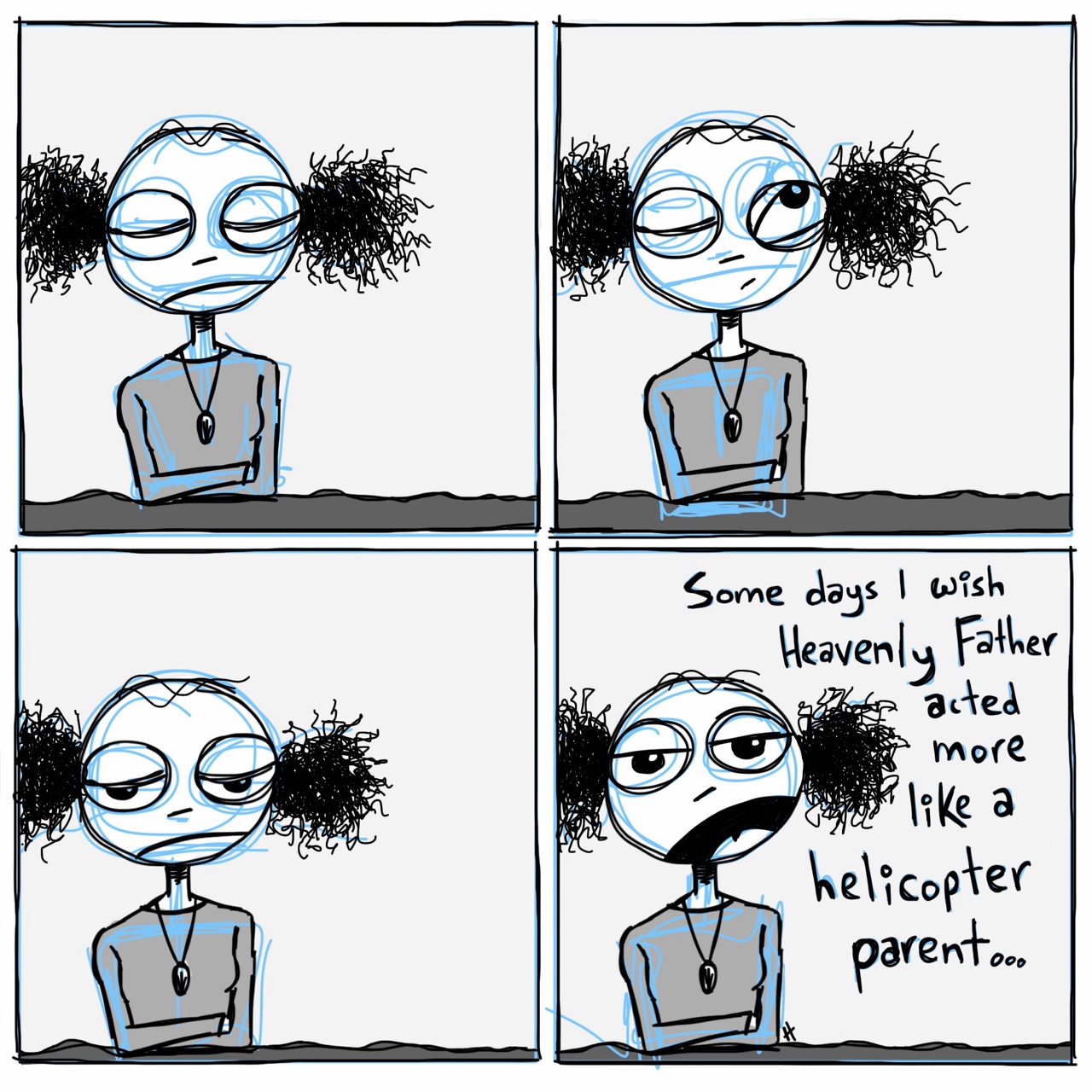
I had been wanting to do a comic for a long time, and I had been wanting to do something with Mormon themes. I had been operating a Twitter account called “Mormon Shorts” for a long time, writing these kind of short, funny Twitter fiction that became kind of popular. I realized that I could tell Mormon stories that people liked. It gathered a following, and I said, “Well, what if I could do this with cartooning?”
I’d kind of become bored of Mormon Shorts anyway, so I switched over to that, and I think that account on Twitter is pretty much dead now. So, that’s also where it came from as well—I realized people liked my humor, and I thought, “Well, what if I could do this with a cartoon character?” And that’s where Enid came from.
Katherine: Okay, that’s interesting. So, that was—for those listening who may not be familiar—that was last December, 2013—
Scott: Yeah, it was a year ago.
Katherine: —that you launched The Garden of Enid.
Scott: Yeah.
Katherine: So, why a weird teenage Mormon girl?
Scott: I don’t know. I think that’s one of the questions people ask the most. I think part of it has to do with my own study of Mormon fiction. One thing that I noticed, at least in serious—what is sometimes termed “serious” Mormon fiction (and that’s a controversial term)—is that a lot of it has to do with the experiences of men and boys. So, you look at the fiction of Douglas Thayer or Levi Peterson and it’s all about the experiences of young men. I like it, I like their fiction a lot—but, I didn’t think I could add anything new to that genre at this stage.
So, I was kind of interested in trying something different. And, frankly, it was just what I drew. I was trying out a lot of things, and she’s the character that stuck. So, it just happened to be a weird teenage Mormon girl. I don’t know; there’s probably a lot I could say about that—it’s just the character that seemed to work best.
You know, I spend a lot of time with females. I have a wife and four daughters, so I’m pretty familiar with girl culture. You know, Disney Channel movies—that sort of thing.
Katherine: How old is your oldest?
Scott: She’s ten.
Katherine: Okay, so she’s a little bit pre-Enid age.
Scott: Yeah. And, you know, I’d just finished teaching seminary. They usually put me in Young Men’s. I’d never really taught Young Women before—but I really enjoyed the perspectives they brought to class. So, I thought it would be kind of fun to try.
Katherine: So, let’s talk more about the story arc—the personal journey that Enid takes. She’s an illegitimate child in a single-parent household. Her mother is not terribly active in the Church.
Scott: Well, I would say her mother is as active as she can be.
Katherine: Right. Which is something that Enid has to deal with and think about and develop some sympathy for. So, I feel like one of the themes is very much—Enid’s not just weird, but she’s not in an ideal Mormon scenario. So, a lot of the struggles are her family doesn’t match the ideal, she’s kind of weird herself, she doesn’t really fit in completely at church, she doesn’t really fit in completely at school.
So, talk to me about those themes and developing those themes.
Scott: From the beginning, the whole theme was to make Enid not fit the mold of the standard Mormon. By doing that I put her in a situation where her mother is sick. She has suffered from many, many different health challenges, the mother. When she was younger, she suffered from addiction and depression—and that’s something that continues.
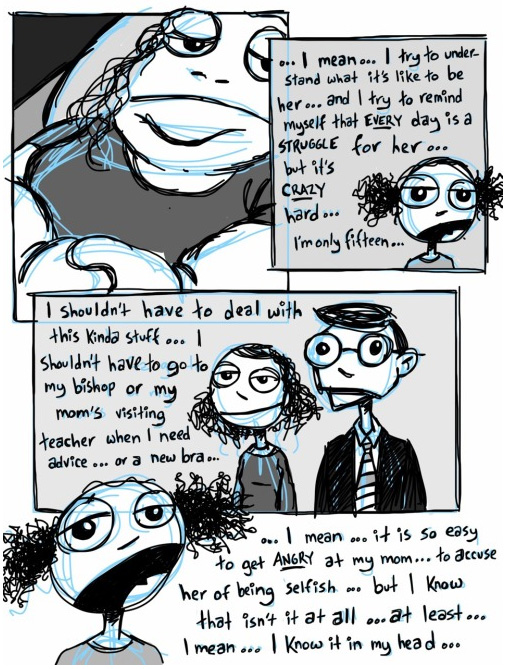
Her relationship with her mother is not ideal, and it’s also not the typical parent–child relationship you would hope to find in the Church. So, Enid does struggle with that. She doesn’t know who her real father is, and a lot of her story, especially near the end, is about her trying to find out who he is and where she comes from.
She struggles socially with people. She has a hard time making connections with real people. There’s a boy she likes. She has people who are friends—they’re more acquaintances, but they’re not really friends. They’re mostly friends by default because they’re in the same ward.
So, she does struggle to make those kind of human connections. Except, she seems to connect well with adults. So, She has these women who step up and kind of fill the mother role for her. And she also has a good relationship with her bishop. So, they’re her support group and the ones she has the most human connection with. They kind of provide the love that she needs.
So, yeah, that’s where she kind of comes from there. I did that intentionally—I wanted a character who would struggle through life, the way a lot of us do but rarely acknowledge in church. She was a good way to talk about non-traditional families, and mental health was especially important to me to talk about. And that sort of thing.
I think I wanted to show a situation that is familiar to all of us, because I think in every ward there are those families that need a lot. They’re very non-traditional, and they need a lot of love—and sometimes they get it, and sometimes they don’t. I wanted her to come from one of those families as a way to talk about the potential of what a ward can do if it gets it right—if they work together and really strive hard to be there for the people who need them the most. So, that’s what motivated that.
Katherine: One of the things I liked about it was that you set up a lot of these stereotypes, through Enid’s perspective, of the Molly Mormon girl, Cyndy; the Marsh family—an also kind of Molly Mormon perfect, seeming perfect to an outside perspective. She has some Young Women leaders who are strait-laced and quote Bruce R. McConkie—some of the more hardliner things that he would say.
Scott: Her seminary teacher is in love with Bruce R. McConkie.
Katherine: Her seminary teacher, yeah. But throughout the comic, they’re all eventually portrayed as more three-dimensional characters and much more sympathetic. And not just as objects for Enid to practice charity and learn compassion, which is part of it—but also as people who end up being, as you said, that support to her.
Scott: Yeah.
Katherine: One of the parts I really enjoyed about the Enid comics were when a Mormon historical figure would pop up that she would talk to. We had Joseph Smith, Wilford Woodruff. Emma Smith showed up a couple times. Minerva Teichert had an appearance. I liked that one. And Eliza R. Snow.
So, where did you get that idea from?
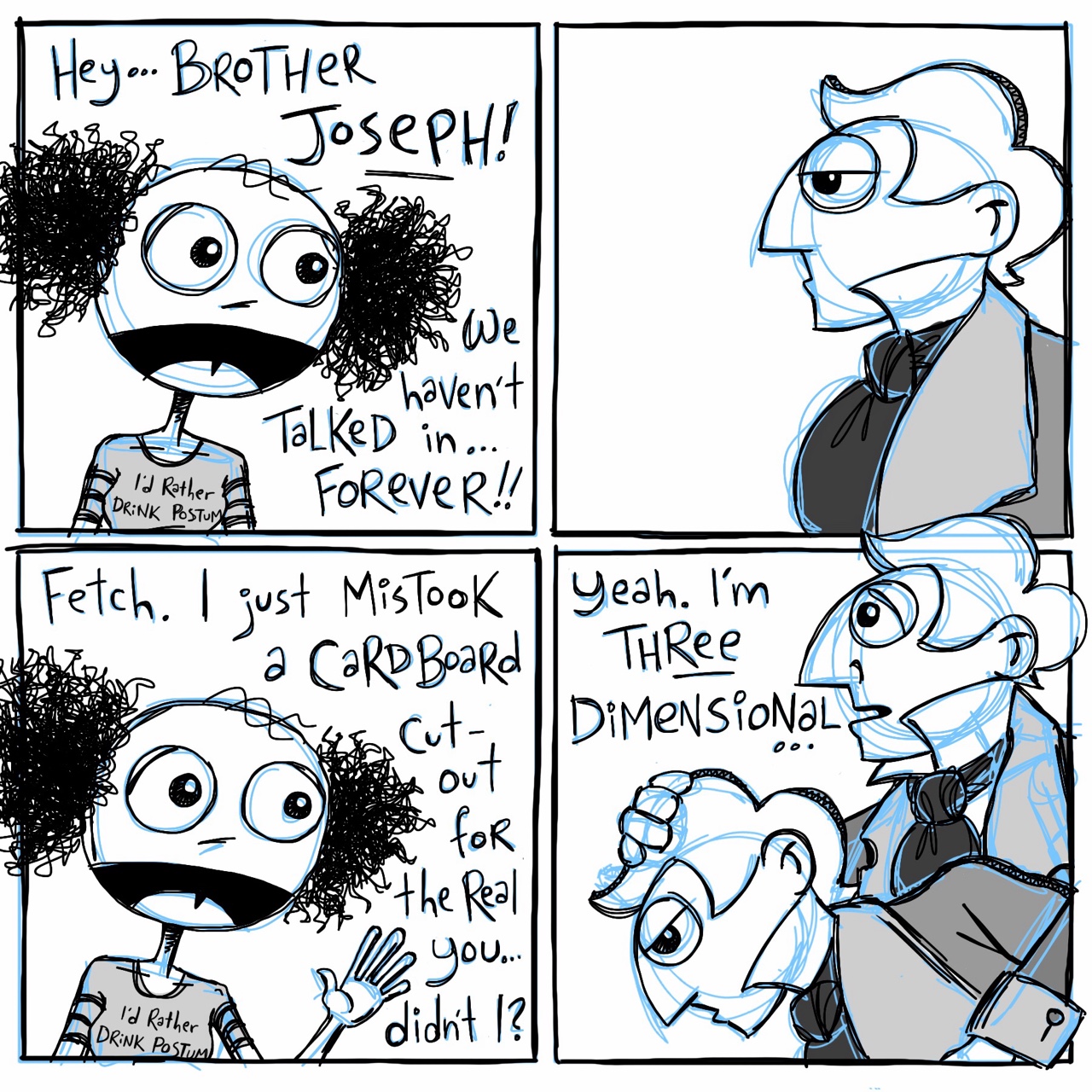
Scott: That’s a good question. The historical figures were one of the nice surprises that happened in the comic, because I’d never planned to do anything like that. My wife’s uncle is an Evangelical pastor, and we’re friends on Facebook. We never communicate; it’s just—it’s family, so you’re friends with them, right? Anyway, he kept posting these comics called Coffee with Jesus. I don’t know if you’ve ever seen Coffee with Jesus before.
Katherine: You know, I think I have seen a couple of those.
Scott: Yeah. It has people asking Jesus these questions, and Jesus is usually very sarcastic. Anyway, I thought it was kind of a fun idea. And I said, well, there’s a lot I want to say about Mormon history. With all the kinds of controversies that are erupting over Church history and Church historiography—how we’ve been telling our stories—wouldn’t it be great if these figures could come back and give us some reflective comments on their life? How would they respond to these controversies with the perspective they have now—100 years later, 150 years later? Wouldn’t it be great if we knew how they felt or what they would say?
That’s what it kind of came from—I wanted Enid to be able to be in conversation with the past, but also at the same time be in conversation with the present. So, a lot of these are moments to talk with these historical figures as if they were around today—as if they had that kind of 20/20 perspective that I imagine they do have now.
And it was always fun—it was always kind of fun to think of, well what would Joseph Smith say here? Which historical figure would be best to respond to this situation? So, that’s where that came from. It was a lot of fun to research these lives and try to figure out what they would say in this or that situation.
Katherine: Yeah, I was actually surprised at how effectively you were able to do caricatures of them. Because I think I haven’t seen a lot of caricatures of Church historical figures, so it was neat how easily identifiable some of them were. Like Wilford Woodruff—I knew immediately that was Wilford Woodruff.
Scott: Yeah, his turned out very well. Some of them not so much, but his was pretty good. I think Bruce R. McConkie, whenever he would appear turned out well.
Katherine: Yeah, he definitely looked like Bruce R. McConkie. The eyebrows.
Scott: I had one person criticize Brigham Young for looking too much like Joseph Smith. They said that Brigham Young looked like Joseph Smith with a beard. So, I did try to avoid that going on from there. But, yeah, that was fun.
Katherine: Were any of the things that came up for Enid struggles that you or your family have had that you kind of wanted to explore and express?
Scott: Yes and no. In a lot of ways—for example, Enid’s struggle with doubts. That’s not really something that I have had much of a struggle with for a long time. I don’t think I’m much of a doubter anymore. But when I was Enid’s age—when I was 15—that’s when I began to learn about some things that I think are challenging a lot of people today.
I was a freshman when I found Fawn Brodie’s No Man Knows My History, a biography of Joseph Smith—very controversial. I found that as a freshman in my high school library, and I read that, and that started me on a path of doubt that went on. My testimony struggled probably for the remainder of my high school years, but like Enid, I kind of worked through it and came to terms with a lot of the messiness of Church history and the gray areas that aren’t supposed to exist in the gospel but do.
So, a lot of her struggles were similar to the same kind of struggles I had then at her stage of life and that I see a lot of people struggling with today. I kind of took my experience and put it in there a little bit. But a lot of it is responding to the struggles I see in the lives of people around me who are having a hard time navigating Mormonism in the Internet age.
In the last year, I’ve had several people that I’ve known just leave the Church over issues with history or doctrine, and I think that’s sad. Enid was one way for me to engage that situation in what I hope was a positive way for a lot of people. Because it’s really sad—I think it’s such a sad thing that’s happening right now.
Katherine: Yeah, I was thinking that to launch a project like this—where you have a character that’s engaging with a lot of her own struggles, and at the same time there are these controversies going on—this was quite the year to do that. It was a coincidence—you couldn’t have predicted that.
Scott: Yeah, there was no shortage of material when it came to controversies this year.
Katherine: I think one of the more memorable episodes from this past year was Enid’s experience at EFY. Tell me about that.
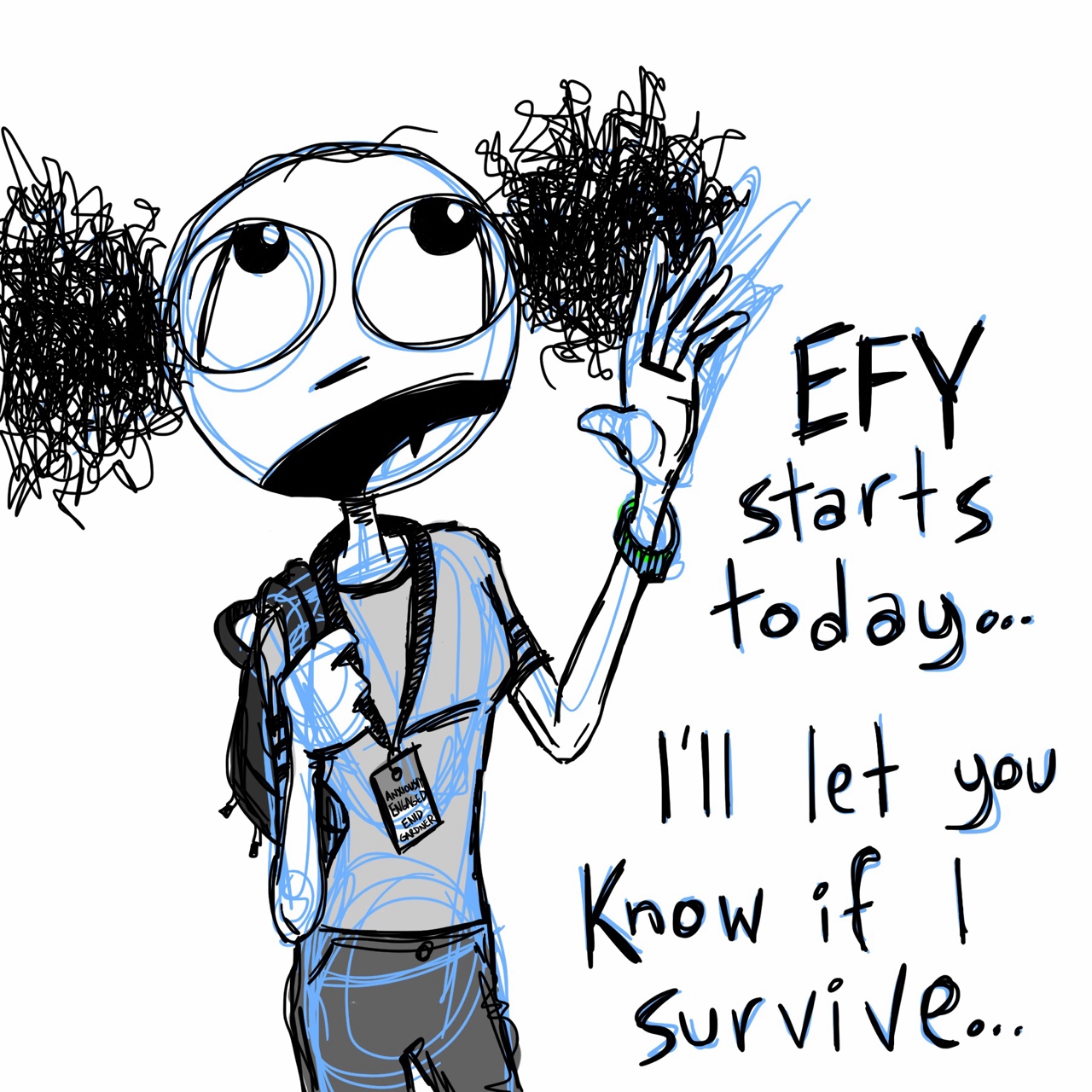
Scott: The idea for EFY came—I think early on I did a comic where her mom’s visiting teacher I guess enrolled her in EFY. I don’t know if that’s what you actually say—but, basically made it so she could go to EFY. She paid for her ticket.
I set that up early on and then realized as summer rolled around that I was going to have to do an EFY comic. The only challenge with that is that I have never actually been to EFY. In fact, I was the teenager—much like Enid—who would make fun of those who would go to EFY and talk about all sorts of horrible ways—all the ways EFY is bad for youth. That was me back in my teenage years. I’ve changed my mind, by the way.
I had to do a lot of research. I got on Wikipedia, and I read about EFY. And I started following the EFY Instagram account. So, I had to do probably the most research for the entire comic on EFY, because I knew basically nothing about it. My wife had gone a few times, so I was asking her about it and basically gave myself a crash course in EFY culture and produced the comic like it did.
Although, I wasn’t quite sure what was going to happen to her, but I knew she was going to get into this love triangle. Initially, the love triangle was going to be between her and—there was a character who kind of came and went; her name was Hallie—it was going to be between Enid, Hallie, and Kyle. Kyle, of course, ended up being gay. That didn’t work out.
I decided not to do it that way—to basically throw her into a situation where everybody was a stranger, where she could reinvent herself. And that’s exactly what happened. I kind of decided it was going to be a turning point in the comic, where she was going to go from the weird, anti-social Mormon girl to one who became more open to new experiences.
So, that’s what it turned into. Originally, I had planned it to be kind of a sad experience for her, and a painful experience—and it was to a certain extent. But then in the end it turned out to be all right for her. I don’t want to ruin it for people who haven’t read it yet, so I’m not going to ruin what happened at EFY; but it’s awesome.
Katherine: Yeah, that was a really fun episode to read.
So, I actually this morning read through your whole year of comics—
Scott: Yeah, I did that last night.
Katherine: —because I hadn’t read all of them. I’d read some of them. I was looking at some of the ones, I mean, it’s interesting when you’re doing something that’s on the Internet and people can favorite it—it’s interesting to see which ones get the most favorites, because that’s some measure, I think, of what’s resonating. Although, not completely—but to some extent.
So, let’s talk about some of those. One of the comics that was favorited a lot was “Enid vs. A Hard Time,” and that one was about Sister Poe’s story. Sister Poe is one of the Young Women leaders in Enid’s ward, and she’s also African American. She was talking about a time when she encountered some racist comments directed to her at church because she was part of an interracial marriage. Then Sister Poe went to see her bishop, and he was embarrassed about the comments that were made, but he also kind of got defensive.
So, then Sister Poe says she learned that “Church is hard. It’s made up of people who don’t always get the Gospel right … which is why the Scriptures emphasize charity and love above all else.” And then Enid says, “So … yeah. That part about church being hard … I get that … which is why it’s nice … with Sister Poe around.”
I think that one actually got the most favorites out of any of your comics. So, what are your thoughts on that one?
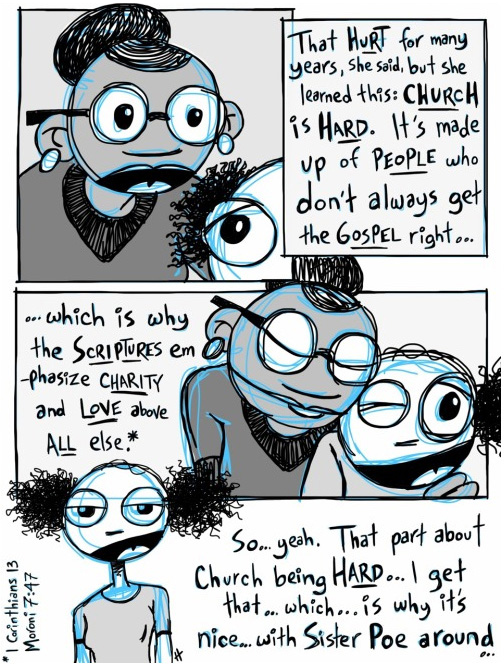
Scott: Yeah, so that is one of my favorite ones, and I think it’s an important one. I was inspired to do it when the author Margaret Blair Young came to Cincinnati. She had worked a lot with African American Mormons in raising awareness about their history.
She came. I helped organize a lecture at the University of Cincinnati that she gave there on the history of Black Mormons. Then she gave a fireside at the stake center two days later, where she talked about more contemporary experiences of African Americans—African American Mormons in the 20th and 21st century. Just reading over their experiences.
I wanted to bring that into this story to include some diversity into the comic and to address that portion of our history and our current situation. I think that’s the way to do it. I think all of us have heard stories like the story of Sister Poe, where somebody in a ward without a whole lot of experience with diversity or African Americans or other minority groups will say something stupid—either because they incorporated some kind of racist folklore into their Church doctrine or something like that. So, they end up saying something hurtful.
What impressed me about Margaret’s talk is that all of these people had stories like that—where someone had done something really hurtful to this or that member. They way they were able to place that in context and find a way to respond with charity rather than anger, kind of do what they could to make the Church a more welcoming place for all races—I was really impressed by those stories she told, and I wanted to add something like that into the comic. That’s what came out of it.
Katherine: Going along with that, I think the one that was favorited the most after that one—I don’t know if you know. It was kind of a one-liner: “Enid vs. Sucky People,” where Enid just says, “I like it when people aren’t sucky to each other.” Were you surprised at the response to that one?
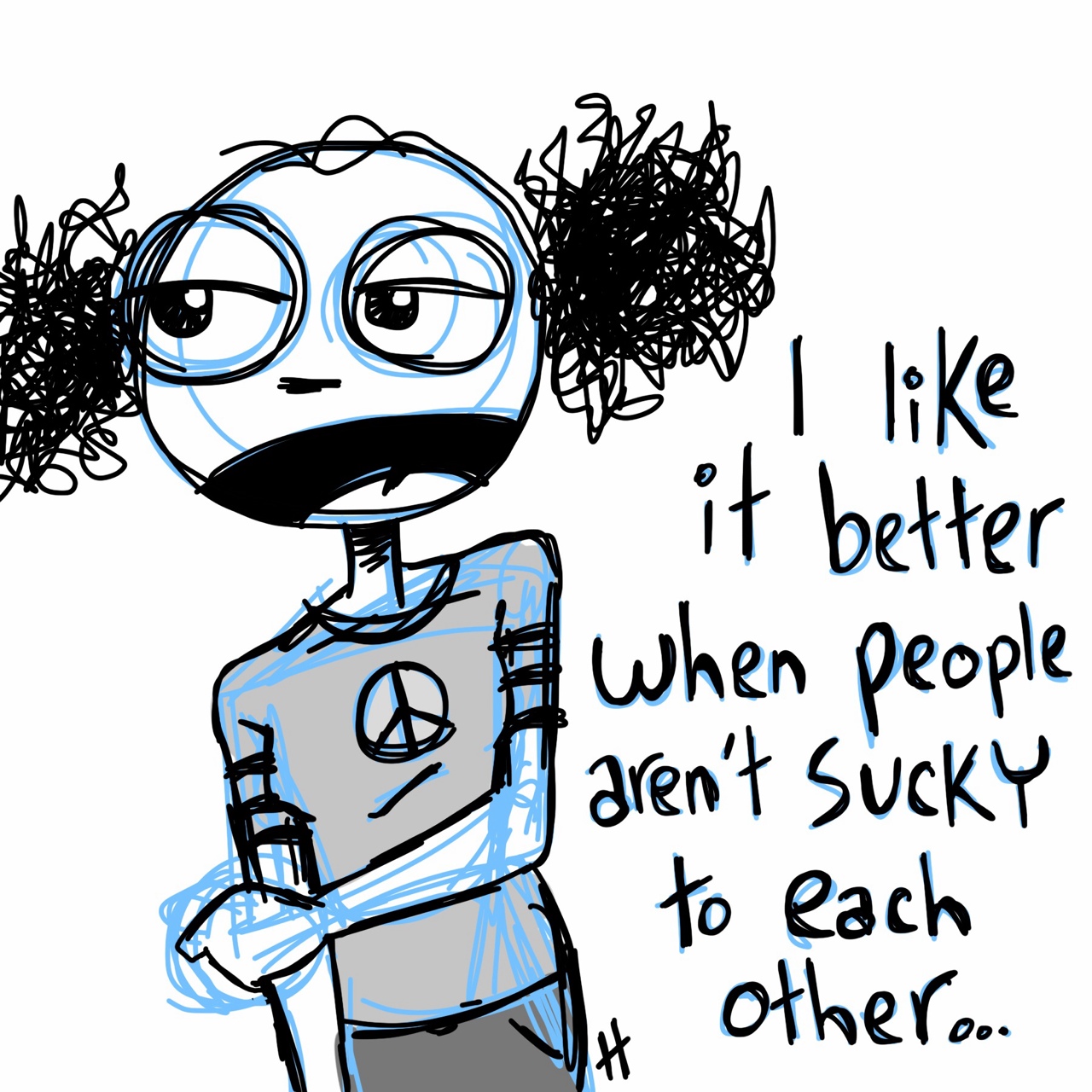
Scott: Kind of. I guess so. That one, interestingly—I think it came out around the time of the Ferguson shooting. I think that was the context of that one. I was just really upset with a lot of the—I was really kind of surprised by the anger from both sides. Here was something really terrible that had just happened, and I was really kind of upset—I think this was especially from conservative news sources demonizing victims.
I just—it kind of bothered me. So, I think that’s where that one came from. But there were other things. I’m always kind of annoyed when events like that become an excuse for people to be mean to each other online. So, that’s where that one came from—I was just frustrated with sucky people being mean to each other.
Katherine: Yeah. Well, I wrote down some of the ones that got the most response just for fun, and a number of them were things like that. Another one was “#PresidentUcthdorf says the Church is a place for Mormons with all kinds of testimonies … ”
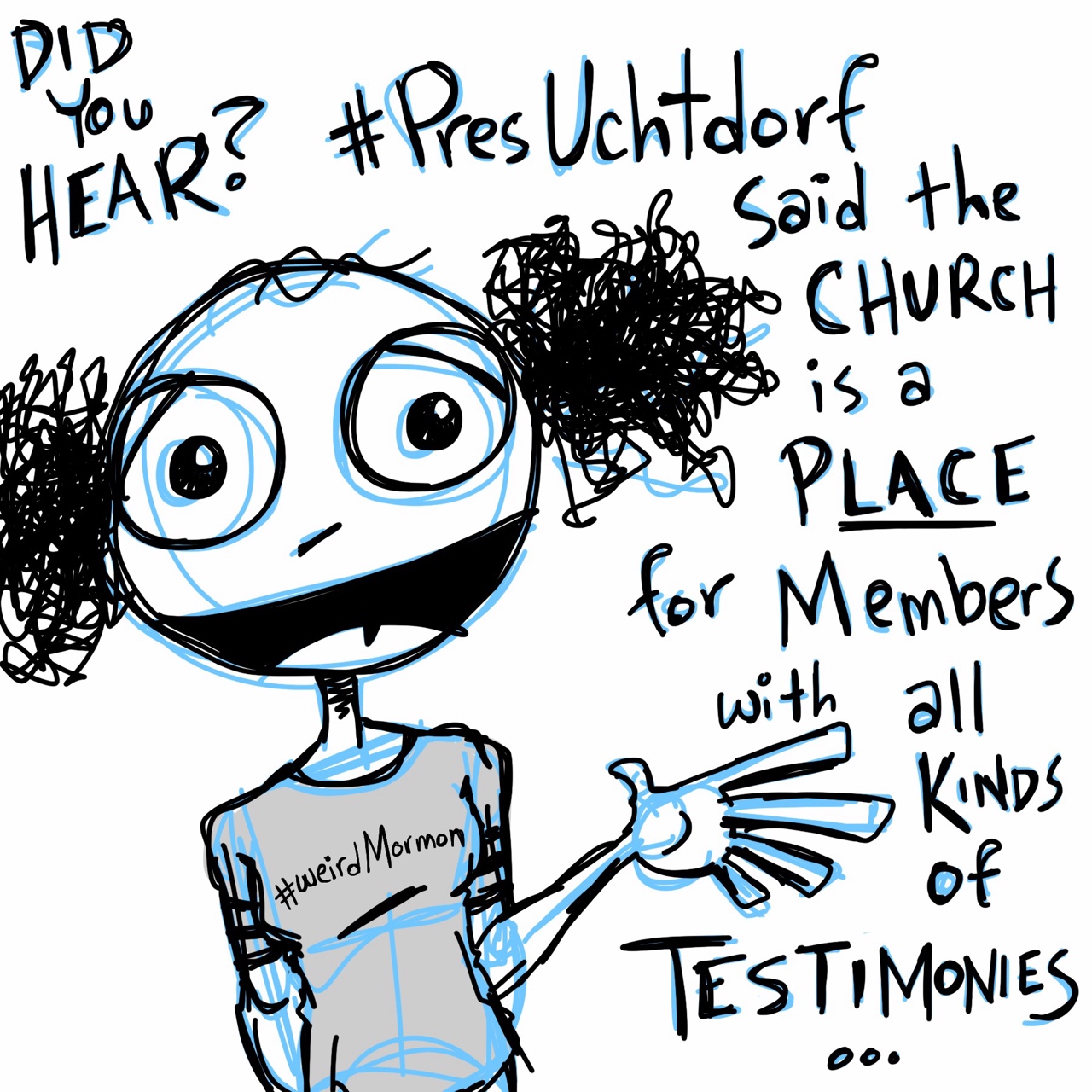
So, I noticed comics that encourage people to show charity and see both perspectives. And then a lot of them also were ones where Enid’s kind of struggling with her testimony. More so than coming to any conclusion is acknowledging the struggle and that it’s okay to struggle. I think those often seemed to be the ones that people responded to.
What have been some of the responses to Enid?
Scott: Most of it has been overwhelmingly positive. There have been a couple of people who do not like it; they’ve told me they don’t like it.
I know early one people did not like my depiction of her mother. I think that was mostly early on. I haven’t heard those criticisms recently. And that was before I’d been able to develop her character and make her more of a real person.
But, for the most part, it’s been overwhelmingly positive. The only downside is that most of the responses I get are from people who think she’s actually real. It was for a while—I was getting at least a couple of messages a week from people, either expressing sympathy for her challenges or struggles.
I had one woman send me her phone number if I wanted to talk it out. A lot of people told me I was a beautiful girl and I’m a sweetie. That sort of thing. That I was strong.
Katherine: That’s really puzzling. What did you make of that?
Scott: I guess you could say I have mixed feelings about the responses. Because, on the one hand they were really fun to read, and funny as well, because people were completely serious and they’d just completely missed the fact that she wasn’t real. So, what they said—I mean, there was a bit of irony there, where they were not in on the joke, so they were fooled, “Ha ha,” that sort of thing.
I do apologize ahead of time to those people if they’re just now finding out about Enid’s fakeness.
But on the other hand, I was really touched by the responses that I would get from these people, because they genuinely cared for Enid, and they really wanted her to do well and be happy.
Sometimes they would share stories with me. So, if Enid was struggling with her mom’s depression, or if she was going through doubts, people would send these messages and talk about their experiences with mental health or mental illness, or talk about their struggles with doubt and just tell me to hang on. I was really touched by that.
I wanted to tell them that it wasn’t real. I wanted to stop them from embarrassing themselves. But at the same time, I felt like that was also part of the experiment, if that makes sense—that I didn’t want to intrude on their experience. I figured as long as I had on the website an “About” section that talked about how it was a fictional webcomic and had links to interviews with me—I felt as long as I had that up there, I was completely off the hook. I don’t know if that’s true, but I felt that way.
So, I just let it happen, and I didn’t try to intervene. I guess I did early on, but I just let it happen, and I let people share their stories with me. I tried to be very respectful of what they shared with me, and I tried to make the comic as honest as possible.
Katherine: Yeah, well, in some ways that does credit to Enid’s character—that she was such a sympathetic character and seemed real, or her struggles seemed real.
Scott: Yeah. My wife would always joke with me about how well I was able to pull off the 15-year-old girl. She would sometimes, if we were watching something, say my 15-year-old girl was showing.
Katherine: Okay, so, on the 23rd, you posted a comic, which kind of rounds out Enid’s story arc. She’s gone to look for her father with some friends from her ward. And it said, “The End.” So, this is the question everyone’s asking: What does that mean? Is this the end the end?
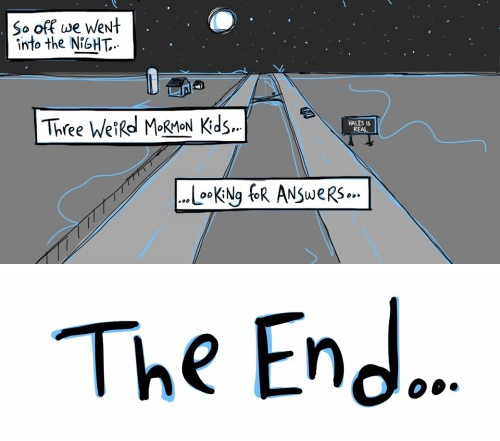
Scott: Yeah. This is the end of Enid, in the sense that we’re not going to see any regular comics from now on. I have just found that producing three comics a week takes a lot of time, and it’s time I don’t have. As much as I think it has been a very worthy project, and I have very few regrets about it, I do have other projects that I want to work on—so I’m going to be doing that for a while.
So, yeah, regular comics will not be appearing anymore. However, I may start up another webcomic based on the Mormon Shorts idea where I have these vignettes of Mormon life. So, I’ll have a comic that basically tells a single-shot story of some aspect of Mormon life.
It could be in that series Enid will show up. Maybe we’ll see one comic or two that features Enid. I’m really kind of interested in exploring the lives of some of her friends. So, you might see comics based on her friend Kyle, or Cyndy, or any of the characters that have appeared in the comic. They might appear. If I end up doing the series, they might appear.
So, I don’t think Enid is completely gone, but you’re not going to see anything regular. And it could be also that if any sort of controversy erupts—if the Church releases a Gospel Topics article that is super controversial and causes all sorts of internal debate on the Bloggernacle. Whatever it may be. Enid may go up and have some sort of commentary on a controversy.
I don’t think she’s gone forever. But as far as a regular comic goes, we’re not going to see anymore, I think for a while. It could be that I do a sequel. I don’t know; we’ll see.
Katherine: So, we may see more webcomics, hopefully, from you in the future.
Scott: I hope so. I have found since stopping the comic that the ideas haven’t stopped coming. I think there’s still a lot in there. I find it really enjoyable—I find that drawing is a very relaxing thing to do. I guess Enid goes walking whenever she needs to clear her mind, and I go drawing.
I really enjoy that, so I’d hate to see that go. But at the same time, I really can’t be producing three comics a week and feel like I’m doing my job as a teacher and literary critic and that sort of thing.
Katherine: So, what do you make of it? Looking back over the year, what have you learned from it?
Scott: Well, I think one thing is there is an audience for Mormon art and Mormon fiction. A lot of times we talk about—that there is no audience. At least in the Mormon fiction community, or the Mormon literature community, we bemoan the fact that nobody’s buying Mormon novels or nobody’s reading Mormon fiction.
That is true to a certain extent, but I think maybe we just are not going about it the right way. There’s an audience out there. I think this comic shows that there are people who can read it, who want to read it, who want Mormon stories, who are okay with realistic Mormon stories that try to show warts as much as needed. Tell Mormon stories warts and all.
It could be that we’re just not finding the right format for those stories. So, when you see something like the success of The Saratov Approach, or what I hope will be success of Freetown—Garrett Batty’s films—you know, maybe film is one way to do that. Mormon movies have worked well in the past, so maybe that’s where Mormon fiction needs to focus.
Comics could be another way that we share fictional Mormon stories. I think the Mormon Lit Blitz has shown that there’s an audience for short web fiction, web poetry.
I think it’s not so much that there’s not an audience for Mormon fiction or for Mormon literature. I think we just need to find formats that are more appealing to audiences today. I think that a lot of Mormons don’t have a lot of time for fiction, but if you put fiction up online, I think they respond to that. Little fragments—serialized fiction. I think there’s an audience for that.
I don’t know. I’m probably not the best person to ask. I tend to prefer fiction that nobody likes. But I think that’s one thing that Enid shows—that there is an audience for Mormon fiction. We just need to find the right way to package it for them.
I think you need to find the right voice for it too. It’s got to hit a sweet spot that appeals to a wide swathe of Mormons, because Mormons are a very diverse crowd, despite the stereotype. I think if you can find the sweet spot that appeals to all stripes of Mormons, you’ve got something good going—you can have some success with that.
I think that’s what worked with Enid—is that Enid did not really appeal to one group of Mormons, but she appealed to all demographics that I’ve been able to come across. Liberal Mormons loved her, conservative Mormons loved her, ex-Mormons loved her, faithful Mormons loved her. They were all represented in the readership, so far as I could tell.
That’s not always easy to do. I don’t know how it happens; it just happens.
Katherine: My last question is just in this past year as you’ve been thinking about telling Mormon stories, since that’s something that you’ve been doing, what are your comments about that? There are a lot of people right now who are telling Mormon stories. So, what are your thoughts about that?
Scott: I think first and foremost you need to tell them. If you have a Mormon story that you feel like you should tell, tell it and tell it honestly. I really do think Mormon art—especially those who write fiction and creative non-fiction—need to put their stories out there and take chances with their art and not be afraid to tell a true story. Fictionalized—a fictional story that speaks Truth with a capital “T,” whatever that truth might be.
Really, just do it. Don’t worry about whether your talents are up to it yet. They’ll get there if you practice at it, if you work at it. That’s another thing Enid shows. If you compare the first comic to the last, there’s a great deal of improvement. That’s what art’s all about, is you’ve got to do it. In order to make something beautiful, you’ve got to start off with something that looks pretty lousy. Just keep at it is what I’d say. And be honest with your stories.
Katherine: Well, thank you so much for spending some time with us.
Scott: Well, thank you for inviting me. This has been fun.
Katherine: And good luck. We hope to see more from you.
Scott: So do I. It will be interesting to see what happens.
Katherine: Okay, we’ll watch for it. ❧
